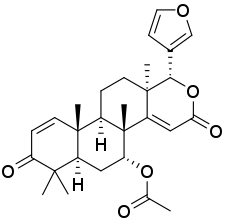Deoxygedunin
Deoxygedunin, or 14,15-deoxygedunin, is a naturally occurring tetranortriterpenoid isolated from the Indian neem tree (Azadirachta indica),[1][2] a plant that has been used in India since ancient times as a remedy for various ailments.[3] Deoxygedunin has been found to act as a potent, selective, small-molecule agonist of TrkB, the main receptor of brain-derived neurotrophic factor (BDNF).[1][2] It produces TrkB-dependent neurotrophic and neuroprotective effects in mice and enhances learning processes.[1][4] In addition, deoxygedunin evokes rapid TrkB-dependent antidepressant-like effects in the forced swim test, an animal model of depression, similarly to 7,8-dihydroxyflavone (7,8-DHF) and ketamine, and notably with a greater potency than 7,8-DHF.[1][2][5] The compound was discovered by the same group that identified 7,8-DHF and N-acetylserotonin as TrkB agonists.[1]
 | |
| Clinical data | |
|---|---|
| Other names | 14,15-Deoxygedunin |
| ATC code |
|
| Identifiers | |
IUPAC name
| |
| CAS Number | |
| PubChem CID | |
| ChemSpider | |
| Chemical and physical data | |
| Formula | C28H34O6 |
| Molar mass | 466.566 g/mol g·mol−1 |
| 3D model (JSmol) | |
SMILES
| |
InChI
| |
With intraperitoneal injection to mice, deoxygedunin crosses the blood-brain-barrier into the central nervous system and possesses a long duration of action, with onset of action at 2 hours post-administration and peaking between 4–8 hours.[1] Relative to 7,8-DHF, deoxygedunin has weaker binding affinity for TrkB (Kd = 1.4 μM).[1][2] However, it is more potent than 7,8-DHF in vivo with intraperitoneal injection in multiple assays.[1] Deoxygedunin has also been found to be orally and topically active.[1][4] Unfortunately, the compound, in contrast to 7,8-DHF, has poor water solubility,[1] and hence its bioavailability, especially oral, may be suboptimal.[6] The researchers who discovered deoxygedunin expressed that they were attempting to find analogues with improved water solubility that retained the biological activity of deoxygedunin, but, as of 2016, there appear to have been no subsequent reports on this effort since the original paper (2010) was published.[1] They also stated in the paper that 7,8-DHF has a simpler chemical structure and that the flavonoids were easier to modify for improved biological effects than the gedunins.[1]
Similarly to gedunin, a closely structurally related compound also found in Azadirachta indica, deoxygedunin has additionally been found to activate HSF1 and induce Hsp70, and was observed to possess neuroprotective effects in a model of Huntington's disease.[7]
See also
- Tropomyosin receptor kinase B § Agonists
References
- Wu, Gen Sheng; Jang, Sung-Wuk; Liu, Xia; Chan, Chi Bun; France, Stefan A.; Sayeed, Iqbal; Tang, Wenxue; Lin, Xi; Xiao, Ge; Andero, Raul; Chang, Qiang; Ressler, Kerry J.; Ye, Keqiang (2010). "Deoxygedunin, a Natural Product with Potent Neurotrophic Activity in Mice". PLoS ONE. 5 (7): e11528. doi:10.1371/journal.pone.0011528. ISSN 1932-6203. PMC 2903477. PMID 20644624.
- Annual Reports in Medicinal Chemistry. Elsevier Science. 24 September 2014. pp. 69–. ISBN 978-0-12-800372-5.
- Vaibhav, Kumar; Shrivastava, Pallavi; Khan, Andleeb; Javed, Hayate; Tabassum, Rizwana; Ahmed, Md. Ejaz; Khan, M. Badruzzaman; Moshahid Khan, Mohd.; Islam, Farah; Ahmad, Sayeed; Siddiqui, M. Saeed; Safhi, Mohammed M.; Islam, Fakhrul (2012). "Azadirachta indica mitigates behavioral impairments, oxidative damage, histological alterations and apoptosis in focal cerebral ischemia–reperfusion model of rats". Neurological Sciences. 34 (8): 1321–1330. doi:10.1007/s10072-012-1238-z. ISSN 1590-1874.
- English, A. W.; Liu, K.; Nicolini, J. M.; Mulligan, A. M.; Ye, K. (2013). "Small-molecule trkB agonists promote axon regeneration in cut peripheral nerves". Proceedings of the National Academy of Sciences. 110 (40): 16217–16222. doi:10.1073/pnas.1303646110. ISSN 0027-8424. PMC 3791704. PMID 24043773.
- Zhang, Ji-chun; Yao, Wei; Dong, Chao; Yang, Chun; Ren, Qian; Ma, Min; Han, Mei; Hashimoto, Kenji (2015). "Comparison of ketamine, 7,8-dihydroxyflavone, and ANA-12 antidepressant effects in the social defeat stress model of depression". Psychopharmacology. 232 (23): 4325–4335. doi:10.1007/s00213-015-4062-3. ISSN 0033-3158. PMID 26337614.
- Kakran, Mitali; Li, Lin; Müller, Rainer H. (July–August 2012). "Overcoming the Challenge of Poor Drug Solubility" (PDF). Pharmaceutical Engineering. Vol. 32 no. 4. International Society for Pharmaceutical Engineering.
- David Gang (3 December 2013). 50 Years of Phytochemistry Research: Volume 43. Springer Science & Business Media. pp. 103–. ISBN 978-3-319-00581-2.